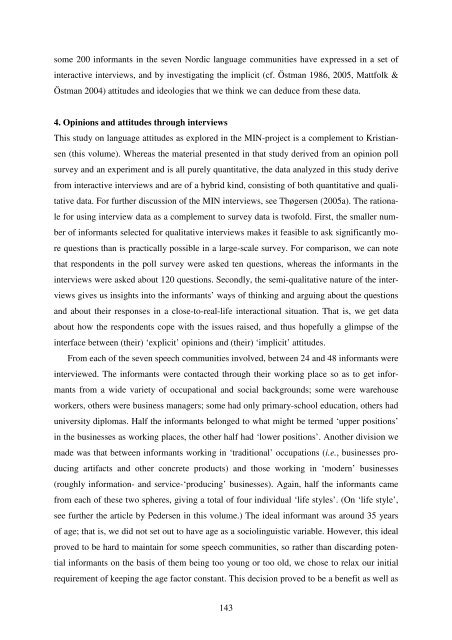Hør dog hvad de siger - Note-to-Self: Trials & Errors
Hør dog hvad de siger - Note-to-Self: Trials & Errors
Hør dog hvad de siger - Note-to-Self: Trials & Errors
Create successful ePaper yourself
Turn your PDF publications into a flip-book with our unique Google optimized e-Paper software.
some 200 informants in the seven Nordic language communities have expressed in a set of<br />
interactive interviews, and by investigating the implicit (cf. Östman 1986, 2005, Mattfolk &<br />
Östman 2004) attitu<strong>de</strong>s and i<strong>de</strong>ologies that we think we can <strong>de</strong>duce from these data.<br />
4. Opinions and attitu<strong>de</strong>s through interviews<br />
This study on language attitu<strong>de</strong>s as explored in the MIN-project is a complement <strong>to</strong> Kristian-<br />
sen (this volume). Whereas the material presented in that study <strong>de</strong>rived from an opinion poll<br />
survey and an experiment and is all purely quantitative, the data analyzed in this study <strong>de</strong>rive<br />
from interactive interviews and are of a hybrid kind, consisting of both quantitative and quali-<br />
tative data. For further discussion of the MIN interviews, see Thøgersen (2005a). The rationa-<br />
le for using interview data as a complement <strong>to</strong> survey data is twofold. First, the smaller num-<br />
ber of informants selected for qualitative interviews makes it feasible <strong>to</strong> ask significantly mo-<br />
re questions than is practically possible in a large-scale survey. For comparison, we can note<br />
that respon<strong>de</strong>nts in the poll survey were asked ten questions, whereas the informants in the<br />
interviews were asked about 120 questions. Secondly, the semi-qualitative nature of the inter-<br />
views gives us insights in<strong>to</strong> the informants’ ways of thinking and arguing about the questions<br />
and about their responses in a close-<strong>to</strong>-real-life interactional situation. That is, we get data<br />
about how the respon<strong>de</strong>nts cope with the issues raised, and thus hopefully a glimpse of the<br />
interface between (their) ‘explicit’ opinions and (their) ‘implicit’ attitu<strong>de</strong>s.<br />
From each of the seven speech communities involved, between 24 and 48 informants were<br />
interviewed. The informants were contacted through their working place so as <strong>to</strong> get infor-<br />
mants from a wi<strong>de</strong> variety of occupational and social backgrounds; some were warehouse<br />
workers, others were business managers; some had only primary-school education, others had<br />
university diplomas. Half the informants belonged <strong>to</strong> what might be termed ‘upper positions’<br />
in the businesses as working places, the other half had ‘lower positions’. Another division we<br />
ma<strong>de</strong> was that between informants working in ‘traditional’ occupations (i.e., businesses pro-<br />
ducing artifacts and other concrete products) and those working in ‘mo<strong>de</strong>rn’ businesses<br />
(roughly information- and service-‘producing’ businesses). Again, half the informants came<br />
from each of these two spheres, giving a <strong>to</strong>tal of four individual ‘life styles’. (On ‘life style’,<br />
see further the article by Pe<strong>de</strong>rsen in this volume.) The i<strong>de</strong>al informant was around 35 years<br />
of age; that is, we did not set out <strong>to</strong> have age as a sociolinguistic variable. However, this i<strong>de</strong>al<br />
proved <strong>to</strong> be hard <strong>to</strong> maintain for some speech communities, so rather than discarding poten-<br />
tial informants on the basis of them being <strong>to</strong>o young or <strong>to</strong>o old, we chose <strong>to</strong> relax our initial<br />
requirement of keeping the age fac<strong>to</strong>r constant. This <strong>de</strong>cision proved <strong>to</strong> be a benefit as well as<br />
143



